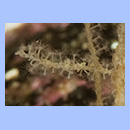- Kingdom: Animalia
- Phylum: Cnidaria
- Class: Hydrozoa
- Subclass: Hydroidolina
- Order: Leptothecata
- Family: Haleciidae
- Scientific name: Halecium labrosum
- Norwegian: -
Characteristics:
Hydroid stage: The branched colony is erect, up to 5 cm in height. There is one main axis and shorter side-branches. These are inserted alternately on each side with an upward curve near the base. The branches are sometimes, somewhat imperfectly though, arranged in a dominating plane.
Medusa stage: There is no medusa stage. Planula larvae are dispersed to entertain the reproduction.
Habitat:
This species is usually registered on solid substrate on depths ranging from 5 to 200 meters.
Distribution:
This is an Arctic and North-Atlantic species, known from both sides of the Atlantic Ocean. The exact distribution is uncertain. A very similar species, H. mediterraneum is registered in the Mediterranean. The differences between northern and Mediterranean specimen are small and there seems to be a gradual change in features, suggesting it is actually the same species. They are still regarded separate species, mainly of "biogeological" reasons.

